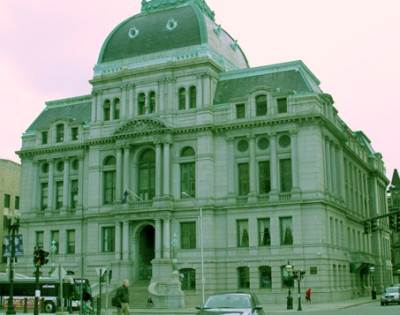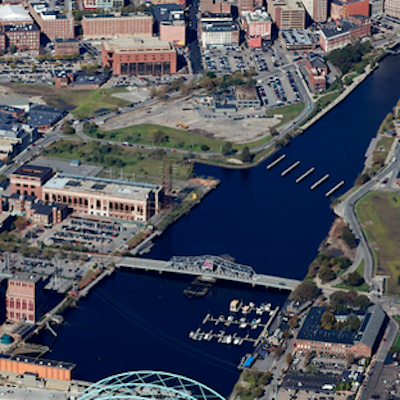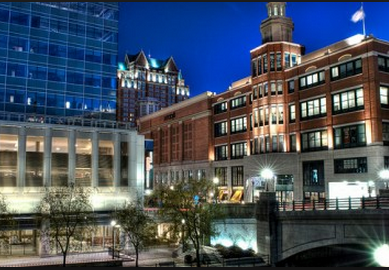Bishop: Keeping the Pawtucket Red Sox Without Seeing More Red in Providence
Thursday, March 05, 2015
We Had Lofty Goals
So what ever happened to ‘Meds and Eds’, to the notion that Providence could grow an even more cohesive version of the Massachusetts 128 circle within its own city limits? The first round of proposals to develop new business on the I-195 land was pathetic, and one obviously can’t wish such an economy into being. But the focus has been dropped in a New York minute for plan B, the ‘Med’ Sox district.
The Speaker of the House seems to have rushed to judgment, favoring the move of the Pawtucket Red Sox to Providence and decrying critics as unduly pessimistic and unwilling to see us invest in ourselves. Easy for him to say when, reading the tea leaves of the new Pawsox owners statements, it appears that the ask is a nice big juicy tax giveaway from Providence. Even if the venture is successful, it is the state that benefits from this project in sales and income taxes, not necessarily the City of Providence.
GET THE LATEST BREAKING NEWS HERE -- SIGN UP FOR GOLOCAL FREE DAILY EBLASTExactly how much can a beleaguered city be expected to invest in its ‘je ne sais qua’?
We share a guarded optimism the new City Council signals something other than the business as usual model in Providence. That would be the ‘winner picker’ model in which any signature project gets eternal tax breaks while the city acts as the state’s beggar going tin cup in hand to the legislature.
You Can’t Keep Giving the Store Away and Expect to Stay Open for Business
The Council can insert a degree of sobriety into a process that has doled out breaks at drunken sailor pace without much to show for it in the way of improving Providence’s tax base. Providence should not give the Red Sox, or any other seemingly glamorous project, property tax breaks that exceed 5 years. That is the typical period that it takes to construct, occupy and stabilize a development and move it to permanent financing.
The blight of Providence neighborhoods full of vacant, foreclosed three-deckers is currently fueling interest in a plan to limit property taxes if they are restored. But even that incentive would be limited to 5 years.
This is a reasonable plan to stabilize Providence neighborhoods but, as can be seen by tracking the progress at Quonset, the short term model is equally effective for large commercial projects. There, the state and the town of North Kingstown have struck a balance when it comes to incentivizing development. The town abates property taxes for the first 5 years for any new construction. It begins with a full abatement the first year and the assessment increasing 20% per year from there until full taxes are due in year 6.
Some will rightfully scoff that such a bid from Providence, where commercial property tax rates are $36.75 per thousand when North Kingstown’s full rate is $18.91, simply can’t be as effective as tax stabilization deals that last 10, 15 or more years! That’s true as far as it goes, but the fact is, every time Providence gives longer term tax abatement to any project, it exacerbates the imbalance that has contributed to the high rate in the first place. This is a vicious cycle that has resulted in Providence charging one of the highest commercial tax rates in the country.
We Should All Be In This Together
What’s worse is that these long term tax giveaways often undermine the incentive that their high profile recipients would have had for civic participation aimed at correcting the structural imbalance in Providence’s finances. Wouldn’t it be wonderful to see someone like Mssr. Skeffington, the new PawSox president, apply his considerable lobbying skills to advocating generally lower taxes in Providence?
Certainly any urban center has to look itself in the mirror and concede that such high tax rates are not solely a product of an eroded tax base, but may represent all form of “chicken in every pot” politics. If Brown University paid taxes on dormitories and food service that compete with local housing and restaurants, the University administration would at least have to balance the tendency of academia to constantly call for ‘justice’, often a euphemism for taxes and regulation, with the reality that the cost of doing business is an important component of justice. It’s all fine and good to support Jobs with Justice but, by extension, No Jobs is No Justice.
Yet, we have seen developers assert that a lack of subsidized private residential developments will simply lead the schools to build fully tax free dormitories. For years we have mistakenly pursued the notion that the solution is tax breaks for virtually all major residential projects -- rather than confront the political elephant in the kitchen. The state legislature should fix this non-profit virus that infects Providence. Commercial activities to feed and house people should be taxed, whether those are well to do students or the working class.
Some Are More Equal Than Others
For some reason, the legislature found the enlightened will to tax Bryant University in Smithfield, but the signature institutions in Providence continue to escape accountability. And the unintended but traceable result of that failure to act is residential projects in Providence continue to be built out paying a pittance of what other Providence owners pay in taxes. These may serve as faux dormitories, filled with students, or they may simply be dormitories for yuppies.
Despite his forever young persona, it probably wouldn’t hold to call Buddy Cianci a yuppie. But the dormitory where he lives, “the 903”, has had what is now an 80% tax abatement for 15 years. The owners have just submitted a request for it to be extended, if at modestly less advantageous terms. But on what basis do we give an excessive 15 year break to ‘grow the tax base’ and then entertain a request to extend it just when our tax base is supposed to grow? This is the Providence that existed before the recent election. One hopes that the new council ends the go along to get along attitude toward these overly generous stabilizations and extensions.
A Full Impact Study Is Needed . . . Can we get there from here?
If the city should limit itself to short term incentives, should the state make up the difference for the ‘Med’ Sox or other projects? The state can look at what taxes would actually be augmented by a new stadium without draining state coffers by lowering receipts from other businesses, and offer to rebate those that reflect the increased contribution to RI’s economy. But from that it must subtract at least a pro-rata portion of the immense infrastructure expense that would be triggered by the project.
State ‘planners’ have already ruined the secondary road system in Providence that, unlike the I-way itself, is a mess. No stadium is going to be located anywhere near downtown Providence without having to add literally an additional Point Street Bridge and extend access ramps to eliminate excessive lights and turns impeding entrances to I-195 east and I-95 North and South.
Economics 101
Asking to take a sober look at a stadium proposal is not a knock on the project, it’s an invitation to get it right. We don’t fail to recognize the tangential value and pride that sports franchises can bring. But, officials must be clearly focused on the absolute need for real economic development in the Capitol City and state.
We wouldn’t be very cosmopolitan if we didn’t at least acknowledge the changing character of minor league stadiums and their yearround commercial integration in urban settings. The new Durham Bulls stadium in North Carolina is a notable model (and subsidized at about the level of McCoy] that sits near an establishment that might be recognizable to Rhode Islanders, the Cuban Revolution restaurant. The reason the Cuban Revolution is in Durham these days and not Providence, where it started, is that the owner realized his utilities, taxes and permits were literally half as much in North Carolina. But he can sell a Cuban sandwich for the same price or more because North Carolina has an economy and people have money to buy sandwiches. Just subsidizing a stadium doesn’t create the economy to go with it.
Speaker Mattiello speaks about investing in ourselves. But stadiums are discretionary spending. It’s a game of picking winners and losers. Fixing our roads and bridges is an investment in ourselves and that’s why government exists. It would have been better if they got city streets right to begin with, but DOT planners were faced with limited resources – and the situation is not helped by the continuing push for ‘apprenticeship’ legislation to drive out small and non-union contracting. To even consider such policy ignores the reality that the state would be better served by both more aggressive and cost efficient investment in our roads -- amenities consistently embraced by our citizens who foot the bill. States that demonstrate that commitment without punishing taxes have a better chance to attract business without giving away the store.
As veterans of the long fight against tolls on the Sakonnet we don’t think the sky is falling because Governor Raimondo mentioned tolls again. The state needs not only to fix broken bridges but mitigate congestion on highways and important secondary arteries. . . not to mention its time that our state university could be reached by a highway besides the information highway and that 95 gets connected to the Newport Bridge. What about a ‘138 circle’ with meds and engineers , privately constructed and funded by tolls? But if tolls are instead to become a resource for feather bedding, you can put us down as adamantly opposed.
Likewise, if a per ticket fee can pay Providence the taxes it needs from a new stadium, that is what negotiation is about. But we cannot insulate the Red Sox, or anyone else, from property tax rates in Providence or they will have no incentive to participate in making and keeping them low.
Brian Bishop is on the board of OSTPA and has managed economic intervention at the Public Utilities Commission in opposition to Deepwater Wind for the fmr. Ocean State Policy Research Institute and presently monitors energy policy with the Stephen Hopkins Center for Civil Rights.
Related Slideshow: The Ten Biggest Questions Facing the PawSox Coming to Providence
If the new ownership of the Pawtucket Red Sox want to build a new stadium in Providence, a number of questions need to be answered. The potential for a major contruction project in the state's capitial city touches upon a number of issues, from money, to politics, to jobs, and development.
Related Articles
- Brian Bishop: A Turning Point in RI: Will Voters Approve a Constitutional Convention?
- Brian Bishop: Rhode Island Energy Policy: The Gift That Keeps on Taking
- Bishop: What Do The State House & Downton Abbey have in Common? An abiding sympathy for King Canute
- Pam Gencarella: A Civics Lesson From the East Bay
- Pam Gencarella: A Race to the Top or Running in Circles?
- Pam Gencarella: RI Has Lost Cabin Pressure
- Pam Gencarella: Witness the Crowding Out of Public Services
- Pam Gencarella: Introducing The People’s Resolution
- Pam Gencarella: Something’s Rotten in the State of Denmark, er, RI
- Pam Gencarella: Ethics is Good Business for Rhode Island
- Pam Gencarella: Another Bubble to Burst in RI?
- Pam Gencarella: Will Spring Bring Renewed Hope to RI?
- Pam Gencarella: Why You Should Care About a Constitutional Convention
- Pam Gencarella: It’s Easy to Vote for Santa
- Pam Gencarella: What’s All the Fuss About RhodeMap RI? If You Like Your Municipality, Keep It
- Gencarella: What Side Are You On? Do Organizations & Consortium Members Really Support RhodeMap RI?
- Gencarella: Are Local Governments Kidding Themselves?
- Pam Gencarella: Surprised, Bewildered, Shocked, Disappointed
- Gencarella: RI Stands Apart From a World Where Change Is the Only Constant
- Pam Gencarella: Don’t Touch That Dial
- Pam Gencarella: Is the Pendulum Swinging Back Toward the Center?
- Pam Gencarella: Context Is What’s Needed - Part I
- Pam Gencarella: Where Does Raimondo’s Vision Put Us in Five Years?
























